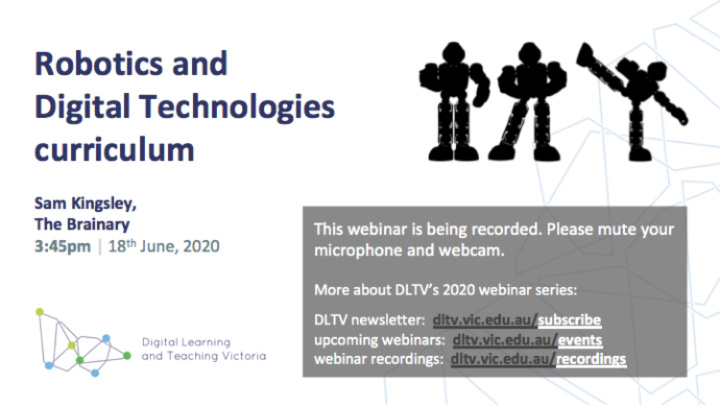



Insert Holding Slide
Robotics and Digital Technologies Curriculum: a practical guide Presenter: Sam Kingsley Technology Manager
Acknowledgement of Country
Today’s Session The Brainary & Sam Kingsley ● Changing landscape of Robotics and ● Education Pedagogical Principles & Robots ● Curriculum Areas & Robotics ● Case studies ● Challenges and Opportunities ● Q&A ●
Background The Brainary Educational Technology Supplier Sam Kingsley Technology Manager BA, Grad Cert STEM Ed
Changing landscape of robotics and Education The educational robotics landscape has changed since Seymour Papert first implemented the turtlebot, but the underlying purpose of the turtlebot is still central to educational robotics today. ● Robotics provide a high level of engagement. ● We can build authenticity into our teaching through the use of robotics. “Logo Turtle” - MIT Media Lab
Changing landscape of robotics and Education The breadth and depth of Educational Robots is ever expanding and it can be difficult to identify the right robotic tool. Two ways I like to distinguish platforms. 1. ‘Hackable’ 2. Practicality in the Classroom. Matansegev photographer
Educational Robotics - Primary Primary School Example “Sphero Bolt” - Sphero.com 1. Sphero Robot 2. Kubo Robot “Kubo Robot” - kubo.education
Educational Robotics - Secondary Secondary School Examples 1. Lego MindStorm “NAO Robot” - softbankrobotics.com 2. NAO “Lego Mindstorm” - https://education.lego.com/en-au/product/mindstorms-ev3
Pedagogical Principles & Robots As professional Teachers you all have what’s called Pedagogical Content Knowledge (PCK) ○ The ability to tailor your teaching to your students on a given topic at a given time to maximise learning. The next step is to turn that PCK into Technological Pedagogical and Content Knowledge (TPACK) ○ The process of incorporating Technological Tools into your teaching practice, so that they become teaching tools rather than disruptions. “The TPACK image” May 2011 - TPACK.org
Australian Curriculum & Robotics Australian Digital Technologies and Design and Technologies curriculum The best fit for robotics is under the ● DigiTech or DesignTech umbrellas. Depending on the robot and context, ● the rationale will vary.
Case Study 1: Robotics and Design - The Knox School (Vic) Robotics has formed one part of a year 7 & 8 unit focused on Technology and Design. Students will spend time learning the ● central facets of Robotics, Art, Visual Communication Design and Media Arts. As a capstone, students will work on an ● “EZ-Robots” EZ-Robot.com opened project based on sustainability. The aim is for students to apply their ● learning in this opened format.
Case Study 2: Remote Learning with Robotics Wyndham Tech School - Remote Robotics Robotic Challenge for students to ● complete from home. Each student participating received ● their own robot. 4 or 5 sessions with Tech School and ● Brainary facilitators “JD Robot” - Ben Davies
Challenges Teacher Training and Professional Development is the number 1 challenge to overcome. 26% of Teachers are teaching out of field in the STEM fields in year 7-10 (Weldon ● 2016). An ever growing curriculum ● 23% of primary teachers have no tertiary studies in either mathematics or ● numeracy (Timms, Moyle, Weldon & Mitchell 2018)
A COVID Silverlining COVID has presented an interesting opportunity. For the majority of Term 2 Australian Teachers have been teaching remotely with students and have been forced to embrace technology to deliver their teaching & learning. “People of a Video Call” Anna Shvets
Questions & Answers
References ASPIRES. (2013). Young People's science and career aspirations age 10-14. London: Kings College. ● Mishra, P., & Koehler, M. (2006). Technological Pedagogical Content Knowledge: A Framework for Teacher ● Knowledge. Teachers College Record, 57(1), 1017- 1054. Phillips, M., & Harris, J. (2018). PCK and TPCK/TPACK: More than Etiology. In E. Langran, & J. Borup (Ed.), ● SITE 2018: 29th International Conference - Society for Information Technology and Teacher. Washington DC. Timms, M., Moyle, K., Weldon, P., & Mitchell, P. (2018). Challenges in STEM learning in Australian Schools. ● Retrieved from Policy Insights: https://researcher.acer.edu.au/policyinsights./7/ Weldon, P. (2016). Out-of-field teaching in Australia Secondary School. Retrieved from Policy Insights: ● https://research.acer.edu.au/
Recommend
More recommend